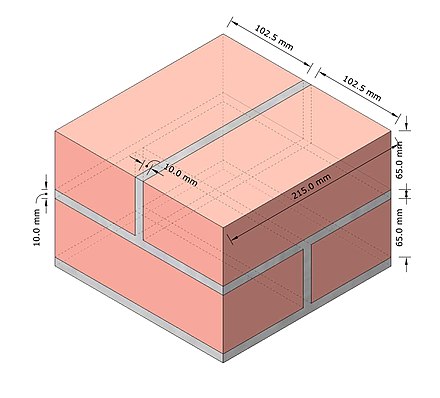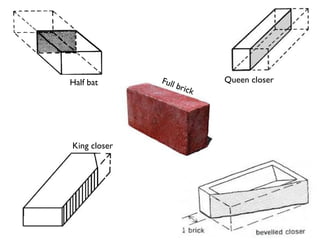BONDING IN BRICKWORK
BONDING
IN BRICKWORK
Bonds in brick work means method of arranging
the bricks in courses so that individual brick units are tied together and the
vertical joints of the successive courses do not lie in same vertical line.
Types of Bonding
PURPOSES
OF BRICK BONDING
§ Obtain maximum strength whilst distributing
the loads to be carried throughout the wall, column or pier.
§ If bonds in brick work are not arranged
properly, then a continuous vertical joint will result. This is called an
unbonded wall having little strength and stability. (See fig. below)
Unbounded wall & Load Distribution in a Well Bonded Wall
§ To ensure lateral stability and resistance to
side thrusts.
§ To create an acceptable appearance.
RULES
FOR BONDING IN BRICKWORK
For getting good bond, the following rules
should be observed.
RULE-1
The bricks should be of uniform size. The
length of the brick should be twice its width plus one joint, so that uniform
lap is obtained. Good bond is not possible if lap is non-uniform.
RULE-2
The amount of lap should be minimum ¼ brick
length along the length of the wall and ½ brick length across the thickness of
the wall.
RULE-3
Avoid using brick bats unless it is necessary or required in special locations.
RULE-4
In alternate courses, the center line of
header should coincide with the center line of the stretcher, in the course
below or above it.
RULE-5
The vertical joints in the alternate courses should be along the same vertical axis.
RULE-6
The stretcher should be used only in the
facing; they should not be used in the hearting. Hearting should be done in
headers only.
RULE-7
It is preferable to provide every sixth course
as a header course on both the sides of the wall.
RULE-8
Use of raked and other joints that provide
horizontal water tables should be avoided. Concave and weathered joints should
be provided.
Types of Joints Between Masonry Units








Comments
Post a Comment